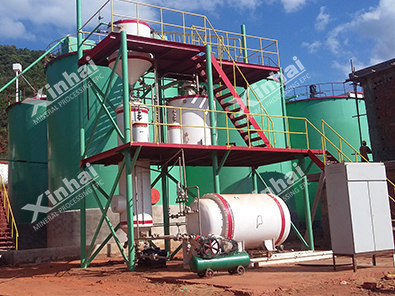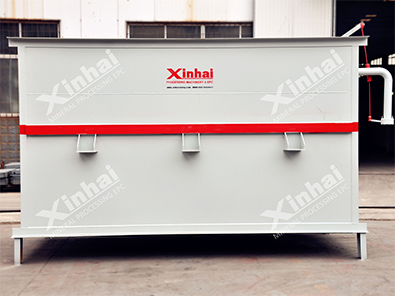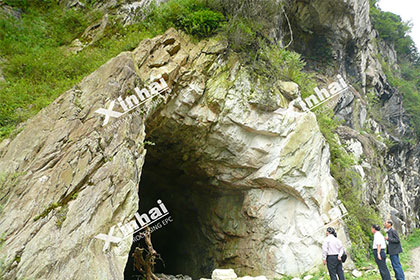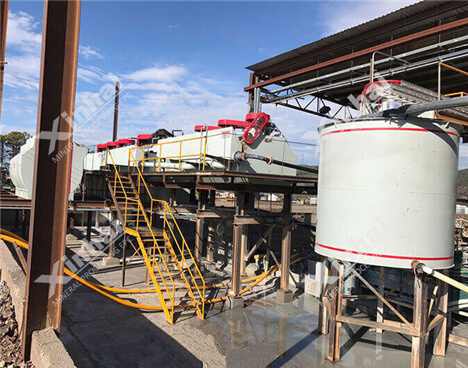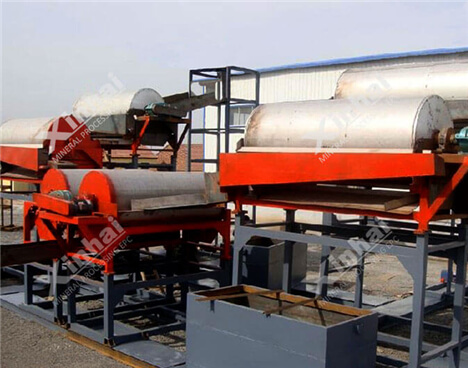A Comprehensive Guide to Agitation Leaching Tanks
 Essow
Essow
 Dec 19, 2023
Dec 19, 2023
 5643
5643
If you want to know more details about equipment, solutions, etc, please click the button below for free consultation, or leave your requirements!
Agitation leaching tanks are widely used in the mining industry for the extraction of gold from ore. This guide aims to provide a comprehensive overview of agitation leaching tanks, including their working principles, design considerations, operational parameters, maintenance requirements, and best practices for efficient gold leaching.
01 Introduction to Agitation Leaching Tanks
Back1. Definition and Purpose
Agitation leaching tanks, also known as leach tanks or simply leaching tanks, are specialized vessels used in the mining industry for the extraction of valuable minerals, particularly gold, from ore. These tanks play a crucial role in the gold leaching process by facilitating the dissolution of gold particles from the ore matrix.
2. Importance of Agitation Leaching Tanks
Agitation leaching tanks are of paramount importance in gold extraction operations. They provide a controlled environment for the efficient transfer of leaching reagents to the ore, maximizing gold recovery rates and ensuring the overall economic viability of the mining operation.
3. Role in Gold Extraction Process
The gold extraction process typically involves the following stages: crushing and grinding of the ore, pre-treatment to prepare the ore for leaching, gold leaching using cyanide or alternative lixiviants, separation of the gold-bearing solution from the remaining solids, and further processing to recover the gold. Agitation leaching tanks are primarily involved in the gold leaching stage.
During the leaching process, the ore is placed into the leaching tank along with a leaching solution, which usually contains a cyanide-based compound. The leaching solution is continuously agitated within the tank to ensure optimal contact between the solution and the ore particles. This agitation promotes the dissolution of gold and other precious metals from the ore, allowing them to be extracted into the leaching solution.
The efficiency of gold leaching depends on several factors, including the contact between the leaching solution and the ore particles, the availability of oxygen, the pH level, and the temperature. Agitation leaching tanks are specifically designed to address these factors and create an environment conducive to efficient gold dissolution.
By providing mechanical agitation and promoting mass transfer, agitation leaching tanks enhance the leaching kinetics, ensuring that the leaching reagents reach all exposed surfaces of the ore particles. This leads to increased gold recovery rates and improved overall efficiency of the gold extraction process.
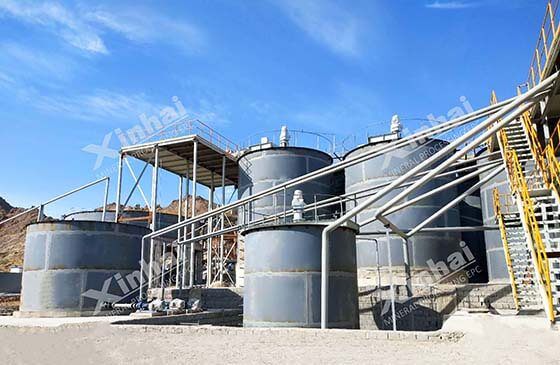
(Gold Leaching Tanks in Iran)
02 Working Principles of Agitation Leaching Tanks
Back1. Overview of the Leaching Process
The leaching process involves the dissolution of valuable minerals, such as gold, from the ore matrix using a suitable leaching solution. In the case of gold extraction, cyanide is commonly used as the leaching agent due to its high efficiency in dissolving gold.
2. Mixing and Agitation
Mixing and agitation are key elements in the working principles of agitation leaching tanks. The primary goal of mixing is to ensure the uniform distribution of the leaching solution throughout the tank and to promote the contact between the leaching reagents and the ore particles.
1. Significance of Mixing and Agitation
Effective mixing and agitation within the leaching tank are crucial for several reasons:
Homogeneous Distribution: Proper mixing ensures that the leaching solution is evenly distributed throughout the tank, minimizing concentration gradients and promoting consistent leaching conditions.
Enhanced Mass Transfer: Agitation facilitates the movement of leaching reagents to the surface of the ore particles, improving the mass transfer of the leaching solution and enhancing the dissolution of gold.
Prevention of Settling: Continuous agitation prevents the settling of solid particles, ensuring that the ore remains suspended in the leaching solution, thereby maintaining an active leaching environment.
Oxygen Supply: Agitation helps to introduce and distribute oxygen within the leaching tank, which is essential for gold dissolution.
2. Role of Agitation Leaching Tanks
Agitation leaching tanks are specifically designed to provide the necessary mixing and agitation for efficient gold leaching. These tanks typically consist of a cylindrical vessel with a centrally mounted shaft that supports one or more impellers.
The impellers are responsible for creating the necessary agitation within the tank. As the impellers rotate, they induce a flow pattern in the leaching solution, resulting in the movement of the solution and the ore particles. This movement promotes the dispersion of the leaching reagents, enhances mass transfer, and maximizes contact between the leaching solution and the ore.
3. Mass Transfer and Reaction Kinetics
The working principles of agitation leaching tanks are based on the principles of mass transfer and reaction kinetics.
1. Importance of Mass Transfer
Mass transfer refers to the movement of leaching reagents from the bulk solution to the solid surface of the ore particles. Efficient mass transfer is crucial for the leaching process, as it determines the rate at which gold and other valuable minerals dissolve into the leaching solution. Proper mixing and agitation within the leaching tank enhance mass transfer by ensuring that the leaching reagents come into contact with all exposed surfaces of the ore particles.
2. Reaction Kinetics in Leaching Tanks
The dissolution of gold from the ore particles is governed by reaction kinetics. The rate at which gold dissolves depends on factors such as the concentration of the leaching reagents, temperature, pH, and the availability of oxygen. Agitation leaching tanks create an environment where these factors can be optimized to promote efficient gold dissolution. The continuous mixing and agitation help maintain favorable reaction conditions, ensuring that the leaching reagents can effectively interact with the gold-bearing ore particles.
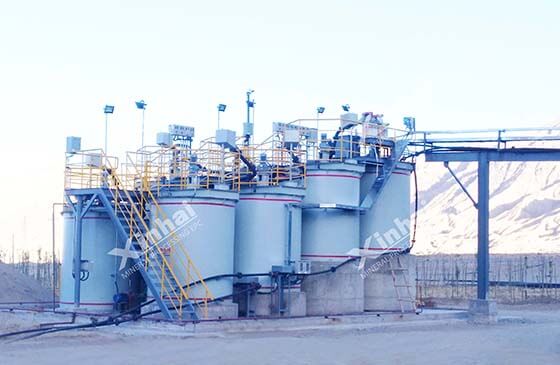
(Gold Leaching Tanks)
03 Design Considerations
BackDesigning agitation leaching tanks involves careful consideration of various factors to ensure optimal performance and efficiency. Here are some key design considerations:
1. Tank Geometry and Size
The geometry and size of the leaching tank play a crucial role in the design. The tank's shape, such as cylindrical or rectangular, affects the flow patterns and mixing efficiency. The size of the tank is determined based on factors such as the desired throughput, residence time, and the volume of the ore slurry to be processed. Proper sizing ensures adequate mixing, residence time, and efficient utilization of the leaching reagents.
2. Impeller Configuration
The selection and configuration of impellers are important design considerations. Different impeller types, such as paddle-shaped, radial-flow, or axial-flow impellers, offer varying levels of mixing intensity and energy efficiency. The impeller size, number, and placement within the tank should be optimized to achieve uniform mixing, promote mass transfer, and prevent dead zones or vortex formation.
3. Baffle Design
Baffles are used to control flow patterns within the leaching tank. The design and placement of baffles influence the direction and intensity of fluid flow, ensuring that the leaching solution and ore particles come into contact with the impellers for efficient mixing. Baffles should be strategically positioned to prevent short-circuiting and promote uniform distribution of the leaching solution.
4. Agitation Speed and Power
The agitation speed and power directly impact the mixing intensity and energy consumption of the leaching tank. The speed at which the impellers rotate determines the energy input into the system. Balancing the agitation speed and power is crucial to achieve the desired mixing and mass transfer while minimizing energy consumption and equipment wear.
5. Inlet and Outlet Design
The design of the tank's inlets and outlets affects the distribution of the leaching solution and the removal of the pregnant solution. Inlets should be designed to distribute the leaching solution evenly across the tank, ensuring uniform contact with the ore particles. Outlets, on the other hand, should be positioned to allow efficient removal of the pregnant solution while minimizing the loss of valuable solids.
6. Temperature and pH Control
Some leaching processes require temperature and pH control for optimal efficiency. Design considerations should include provisions for temperature control systems, such as heat exchange mechanisms, to maintain the desired operating temperature. pH control systems, such as the addition of alkaline or acidic reagents, may also be incorporated to adjust and monitor the pH level within the tank.
7. Materials of Construction
The choice of materials for constructing agitation leaching tanks is critical. The materials should be compatible with the leaching reagents and the ore being processed. Corrosion-resistant materials, such as stainless steel or specialized alloys, are often used to ensure durability and prevent contamination of the leaching solution.
8. Safety Considerations
Safety is an important aspect of tank design. Adequate safety measures should be implemented to protect personnel and prevent environmental hazards. This includes proper ventilation systems, appropriate access points, safety interlocks, and spill containment mechanisms. Compliance with safety regulations and industry standards is essential during the design process.
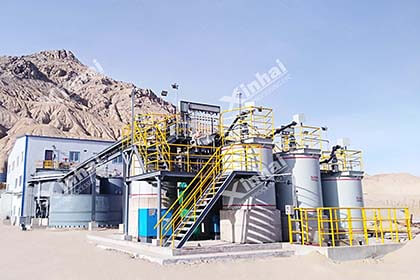
(Gold Leaching System)
04 Best Practices for Efficient Gold Leaching
BackEfficient gold leaching requires the implementation of best practices throughout the process. Here are some key practices to consider.
1. Ore Preparation
Proper ore preparation is crucial for efficient gold leaching. This involves crushing and grinding the ore to an appropriate particle size to expose the gold-bearing minerals. The particle size should be optimized to ensure maximum surface area and accessibility of gold for the leaching solution.
2. Leaching Reagents
Selection and optimization of leaching reagents are vital for efficient gold leaching. Cyanide is commonly used as a leaching agent for gold extraction. The concentration and composition of the leaching solution, such as cyanide concentration, pH, and the addition of other additives, should be carefully controlled and monitored to achieve optimal leaching conditions.
3. Agitation and Mixing
Proper agitation and mixing are essential for uniform distribution of the leaching solution and effective contact between the solution and the ore particles. This promotes mass transfer and enhances gold dissolution. Maintaining appropriate agitation speed, impeller configuration, and baffle design are critical for efficient mixing and avoiding dead zones or short-circuiting.
4. Oxygen Supply
Adequate oxygen supply is crucial for gold dissolution. Oxygen enhances the reaction kinetics and facilitates the oxidation of gold. Proper oxygenation can be achieved through the use of air spargers, oxygen injection systems, or other methods to introduce and distribute oxygen within the leaching tank.
5. Residence Time
Optimizing the residence time ensures sufficient contact between the leaching solution and the gold-bearing ore particles. The residence time should be carefully balanced to allow for efficient gold dissolution without excessive time requirements. Proper tank sizing, feed rate control, and process monitoring contribute to achieving an optimal residence time.
6. Temperature and pH Control
Maintaining appropriate temperature and pH conditions can significantly impact the leaching efficiency. Temperature control systems, such as heat exchange mechanisms, can ensure consistent operating temperatures. pH control systems, using alkaline or acidic reagents, help maintain the desired pH level for efficient gold dissolution.
7. Monitoring and Control
Continuous monitoring and control of critical parameters, including temperature, pH, agitation speed, oxygen levels, and cyanide concentration, are essential for efficient gold leaching. Real-time monitoring and feedback systems allow operators to make timely adjustments to optimize process conditions and maximize gold recovery.
8. Safety and Environmental Considerations
Safety and environmental considerations should always be prioritized in gold leaching operations. Appropriate safety measures, such as proper ventilation, personal protective equipment, and spill containment systems, should be implemented. Compliance with environmental regulations and responsible management of leaching reagents and by-products are essential to minimize environmental impacts.
9. Process Optimization and Innovation
Continual process optimization and innovation are key to improving gold leaching efficiency. Regular evaluation of process performance, data analysis, and identification of improvement opportunities can lead to enhanced recovery rates and reduced operating costs. Exploration of alternative leaching technologies and approaches may also uncover more efficient and sustainable methods for gold extraction.
05Conclusion
BackBy following the best practices above, gold leaching operations can maximize gold recovery rates, minimize energy consumption and reagent usage, ensure the safety of personnel, and reduce the environmental impact of the process. Regular evaluation, optimization, and innovation are crucial for achieving long-term success and maintaining competitiveness in the gold mining industry.
It is important to note that local regulations, environmental considerations, and specific ore characteristics may influence the design and implementation of gold leaching processes. Therefore, it is recommended to consult with experts and adhere to applicable guidelines to ensure safe and efficient gold leaching operations.
Efficient gold leaching not only contributes to the economic viability of gold mining but also supports sustainable practices by minimizing the consumption of resources and mitigating environmental impacts.
If you need to buy any kind of mineral processing machines, feel free to contact online customer service.
 +86 182 3440 3483
+86 182 3440 3483 yanzhang19990421@gmail.com
yanzhang19990421@gmail.com




 Message
Message Chat Now
Chat Now



